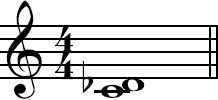Minor second interval
 The minor second interval consists of two notes with one half step distance. For example, C to Db note will result in this musical interval.
The minor second interval consists of two notes with one half step distance. For example, C to Db note will result in this musical interval.
The minor second interval is abbreviated m2 whereas the major second is abbreviated M2. An alternate spelling of minor second is augmented unison.

A minor second with C to Db on the keyboard.
Listen to the minor second interval (C-C#):
The sound of this harmonic interval is dissonant, which is a result of two closest notes played together.
In major scales, the minor second interval is represented twice. For example, in C Major (C, D, E, F, G, A, B), the minor seconds are E-F and B-C.
To distinguish intervals, a good idea is to think of familiar songs which beginning notes match. A well-known example in this case is "Für Elise" (E-D#).
A minor ninth interval is the same as minor second on next interval (or compound minor second, which is the correct term).
Ascending minor second intervals
A list of ascending minor second intervals:
- C – C#/Db
- C#/Db – D
- D – D#/Eb
- D#/Eb – E
- E – F
- F – F#/Gb
- F#/Gb – G
- G – G#/Ab
- G#/Ab – A
- A – A#/Bb
- A#/Bb – B
- B – C
Descending minor second intervals
A list of descending minor second intervals:
- C#/Db – C
- D – C#/Db
- D#/Eb – D
- E – D#/Eb
- F – E
- F#/Gb – F
- G – F#/Gb
- G#/Ab – G
- A – G#/Ab
- A#/Bb – A
- B – A#/Bb
- C – B
Enharmonic notes such as Cb and Fb are omitted.
Read more about intervals and use the interactive Piano Interval Finder tool.